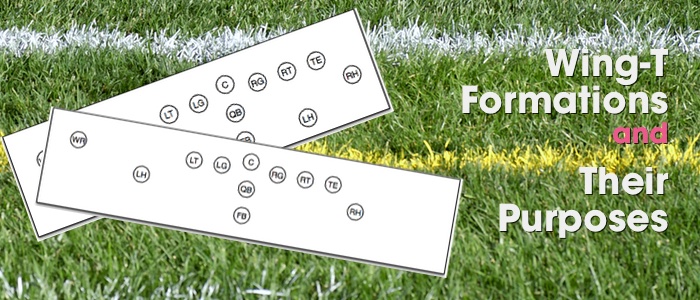Wing-T Formations and their Purposes

It is mid-season for most of you and you might be starting to experiment with some different Wing-T formations. Any time you introduce a change in your system, it should be with a purpose. Let’s explore some of the formations I’ve used and the key rationale behind each.
The Classic Wing-T Formation (100 / 900, Right / Left)

The classic Wing-T formation is called 100 / 900, in Sherwood we just call these Right / Left. This formations uses a halfback (or diveback) in the backfield behind the weak side tackle, and a wingback off the tight end. The fullback is in his normal position, 4 yards back from the ball directly behind the quarterback who is under center.
This formation has its roots in the Buck series, with the wingback primarily being an edge blocker and the halfback being a ball carrier. In fact, some teams will flip their backs and use a stud blocker (think H back in modern offense) permanently in the wingback position. You also have many options for running the fullback here, such as the Buck trap play, off-tackle Down, or the weak-side Belly / ISO play. I prefer having the lead blocker in the ISO play coming from the halfback position vs. wingback as he has better visibility through the hole.
A downside of this formation if you run the Jet series is that you can only run jet sweep to the weak side away from the tight end.
The Double Wing Formation (Red / Blue, Rose Lily)

When you move the halfback up to a wingback position off the weak tackle, you are in the classic Red / Blue formations (we call them Rose and Lily). With the balanced wingbacks you get some great options for attacking both flanks without losing many of the options you have in the traditional Wing-T formation. This is because you can easily put either wingback in motion to bring him into a halfback position at the snap.
You can now run jet sweep to either side, rocket sweep to either side. I like the rocket motion to start from the wing position to simplify timing for the snap and pitch and to allow the back to get to full speed and proper depth.
The Down sweep play is easier to work when you have a wingback as he is a bit further away and the extra steps allow time for the quarterback to ride a full belly fake before giving the ball on the sweep.
Overloaded Backfield Formations (Slide, Flip)

There are times when we’ll move the halfback over the wingback side, or the wingback over to the halfback side to created an overloaded or unbalanced backfield. This is similar to creating an unbalanced line and we usually do it to give us more bodies at the point of attack. For example, instead of just running a weak side ISO play to the fullback, you can flip the halfback over to the strong side and run a strong power ISO play. The wingback can go straight to a middle backer, you can double team with the tackle and tight end, kick out with the playside guard, and have the halfback lead through the hole.
Especially in youth football, don’t overestimate the ability of a defensive coordinator to react properly to an unbalanced look like this. Without an eye in the sky, it can be very hard to see this from the sideline. I know from experience: last year as a defensive coordinator it took a full half for me to realize our opponent was running a new tackle over unbalanced line.
You can also create an unbalanced backfield through motion. We run a formation called L and R where we have the strong wingback (behind the TE) in the halfback position and the other in a wingback position. We’ll run jet motion with the wingback to the TE side but use him to kickout on a power FB play. We call this Hammer and you can find the full play in my playbook.
Breaking Tendencies with “formation sugar”
Finally, sometimes you’ll want to run the same plays from different formations just to break tendencies. For example, if you always go to the Right/Left formation to run Buck Sweep, you may be giving a key read to the defense. Run it from the double wing formation as well to mix things up. Scout yourself and use Hudl to break down your own offense to see if you have any plays you are only running from a single formation.